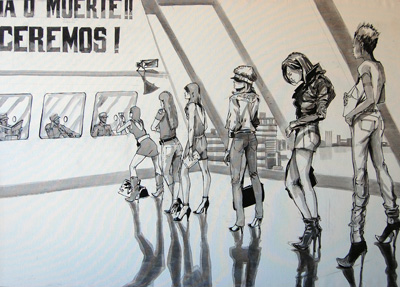Chromatic Relations made in Pedro
By Daniel G. Alfonso
Color stains. Textures. Pasting. Art books on the table of his studio share space with his pieces and work materials. Several blank canvases wait for the artist to approach and start his experimentations and the new researches he is carrying out on contemporary painting. Pedro Valerino (Manzanillo, 1981) is transforming the most traditional of art forms with his work and at the same time granting new values to painting with a more contemporary glance.
His work, I would say, is part of the abstract expressionistic trend that emerged in the late 1940s, including certain influences of Motherwell’s strokes, Rothko’s contemplative line and Ad Reinhardt’s painting minimalism. Starting from these somewhat historical determinations Valerino has taken advantage of each lesson, each reading, and each museum visit to elaborate his own visual codes.
Despite the arbitrary or subjective distribution of color in his works, we appreciate a precise handling of his brush and spatula. Each canvas is a visual object that induces to touch and feel each one of his strokes. He knows how to play with the viewers’ senses. His creative process has evolved from the horror vacui in his series A Word, Love, Pages to a more experimental painting where he explores with new supports and materials.
Pedro Valerino has consequently followed a path that seeks a unique aesthetic and formal line. A blank canvas is the means to make traces in different shades, as if his practice were based on Philip Ball’s text The Invention of Color. Our glances stop to contemplate each detail, because the artist strives to create a mental condition in the viewer using concepts such as space and their painting solution. His works produce both pleasure and concern, isolating us completely from our daily environment and leading us to other universes, succeeding in focusing our attention exclusively on what we are observing.
Our artist’s creation presents us with a new language that, while connected to international art, preserves the own roots. He profits from his traditions, makes reference to Pedro de Oraá, Martínez Pedro, and Loló Soldevilla to achieve a new language in abstract art, a new vocabulary made in Pedro.
Valerino’s works remind me of a phrase of art critic Marta Traba, who states that abstraction “is born from the wish to freely express emotions and sensations, thus justifying the stain or loose stroke with the spiritual force of the empty space. That is why a poetic shade repeatedly appears in groups or individual artists.” Abstract art, since its start, has never denied or opposed reality; on the contrary, it inserts itself in it and is regarded as a sharp and extensive answer of its multiple and changing state in time and space.
From now on I will closely follow the work of this artist. Why hadn’t I heard from him? Anyway, with this text he is already part of my knowledge of contemporary Cuban painting. Keep going ahead, Pedro, with your reflexive, empathic and ludic work.



